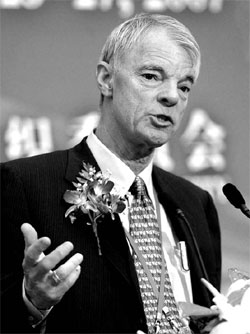Economy to sustain fast growth for 2 more decades
By Chen Weihua (China Daily)Updated: 2007-06-11 09:00
|
Michael Spence: China's economy will sustain its fast growth for at least two more decades. |
These are the words of no less a person than Stanford University professor Michael Spence, who shared the 2001 Nobel Prize for Economics with Columbia University professor and former senior vice-president of World Bank Joseph E. Stiglitz and University of California (Berkeley) professor George A. Akerlof.
In the post-War period, 11 economies have recorded high growth, with eight of them being in Asia: the Chinese mainland, Hong Kong, Taiwan, Singapore, Indonesia, South Korea, Malaysia and Thailand, Spence says. Going by gross domestic product (GDP) figures, "high growth" means above 7 percent expansion, and an economy is said to have "sustained growth" if it keeps growing for 25 years or more. Growth at such rates produces very substantial changes in income and wealth.
The Chinese mainland is not only the latest example of a high-growth economy, but it has also seen the fastest and largest increase in growth in terms of population, says the senior fellow of Hoover Institution, a top US think tank. India too has attracted a lot of attention because it is entering a period of high growth.
"Though each growth model is different, they share certain features," Spence told the Shanghai Forum 2007 at the Fudan University in late May. "In all cases, there is a functioning market economy with its price signals, incentives, decentralization and enough definition of private property ownership to enable investment."
|
A labourer installs a steel bar at a
construction site in Kunming, capital of southwest China's Yunnan
Province, June 8, 2007. China's almost three decades of high growth is the
longest among the 11 high-growth economies in the world, says Stanford
University professor Michael Spence.
[Reuters] |
The most important feature of sustained high growth is that it leverages the demand and resources of the global economy, says Spence. All cases of sustained high growth in the post-War period have integrated into the global economy because exports act as a major high-growth driver.
"The systematic reduction of barriers to trade and investment in the last 55
years and the dramatic fall in costs of transportation, information and
communications technologies have combined to raise the level of that
integration. It is the combined effect of these trends that has made the global
economy an increasingly powerful source of potential growth."
| 1 | 2 |  |
(For more biz stories, please visit Industry Updates)

